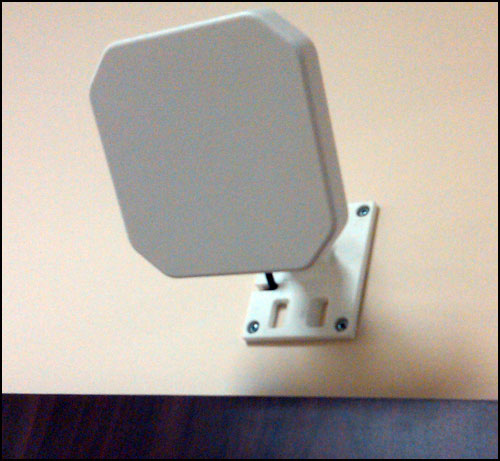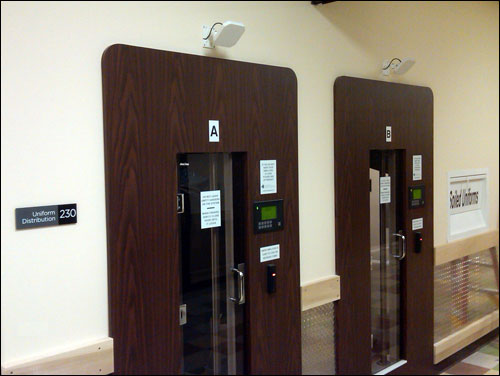This week, employees at the Fallsview Casino Resort, located in Niagara Falls, Canada, are sewing ultrahigh-frequency (UHF) radio frequency identification tags into tens of thousands of garments comprising employee uniforms, as part of a system that will provide visibility into the cleaning and reissuing of the outfits to workers, as well as automating a portion of that process. The solution is slated to be taken live next month (see RFID News Roundup: Fallsview Casino Resort Selects RFID to Track Uniforms).
RFID readers located in the facility’s laundry area will track when each uniform is sent to be cleaned, along with the time of laundering and when that garment is ready for reuse. Conveyors will transport the clean uniforms to locking windows outside the laundry area, to be picked up by the resort’s 3,500 restaurant, hotel and casino workers at the beginning of each shift. Not only will this improve the efficiency of providing staff members with uniforms, but it will also allow the resort to manage how often the garments are laundered, and when they need to be replaced.

Fallsview Casino Resort is the latest customer to employ the GIMS UHF-RFID tracking system, provided by California uniform and linen efficiency technology firm InvoTech Systems. The GIMS solution consists of UHF tags sewn into each uniform, as well as readers and software to manage data from those devices. The resort has initially purchased 40,000 of InvoTech’s Fujitsu Frontech North America rubber-encapsulated labels for this purpose. Each tag, according to Jeff Welles, InvoTech’s VP has a unique ID number that is linked in the GIMS software to the particular type of item, as well as its laundering history.
The resort’s solution also includes Impinj Speedway Revolution readers, along with AN720 and AN480 antennas from Motorola Solutions, for tracking uniforms’ locations. What makes the system unique is the use of the RFID system with conveyor technology, from White Conveyors, that operates with the GIMS software to provide employees with their uniforms without the need for assistance from co-workers.
At the time that the new tags are attached, a staff member utilizes an Impinj reader to interrogate each tag ID. The reader is wired to the resort’s back-end system, where InvoTech’s GIMS software stores the tag’s unique ID. A worker then uses a drop-down menu to select which type of item it is—such as a shirt, jacket or trousers—as well as its size, and to enter a stock-keeping unit (SKU) number.
Uniforms are then assigned to specific employees. As each staff member receives his or her uniform, the garment first passes over a reader antenna built into a counter, and the recipient’s name is input into the system. From that point on, that worker will continue to use that specific uniform, and as each shift ends, he or she can simply drop the soiled garment down a chute.
The dropped uniform then lands in a wheeled basket at the bottom of the chute. Once the basket is full—typically, twice daily—it is rolled past an Impinj reader en route to the laundry room. The device captures the ID numbers of all labels within the basket, which could total 500 or more. Those IDs are transmitted to the GIMS software, which updates each uniform’s status. After being washed and dried, the outfits pass the reader once more while moving in the other direction (leaving the laundry room), and the device again captures the ID numbers and updates the garments’ status. The positioning of antennas enables the interrogator to detect in which direction the basket is travelling (and, thus, whether the contents are clean or soiled).
The laundry staff can then remove the laundered uniforms from the basket, and place them on hangers suspended from one of four conveyors. Each garment is assigned to a particular slot on one of the conveyors, and staff members must manually match the ID printed on the label with the particular conveyor and slot number assigned to that uniform (and, thus, to a specific employee).

Upon picking up a laundered uniform at the beginning of each day, a worker first presents his or her proximity card to a reader situated at one of four “U-Pick-It” doors (there is one conveyor per door), located outside the laundry area. The GIMS software retrieves the employee ID, links it to the corresponding slot number for that individual’s uniform and then instructs the conveyor to move that garment’s slot to a position directly in front of the door. The GIMS software also triggers the glass door to unlock. As the employee removes his or her uniform through the door, the outfit passes under an RFID reader antenna mounted on the ceiling, and the software links the uniform’s RFID number with that employee, updating the garment’s status as having been retrieved by that staff member.
By using the system, the resort will be able to provide uniforms to staff members more efficiently, without requiring paperwork and manual assistance for retrieving and checking out the garments. But more importantly, Welles says, the system enables users to better track inventory levels, in order to view how often uniforms are laundered, when they are approaching the end of their lifecycle (based on the number of washes) and how quickly the garments move through the washing process. Welles estimates that the tags can sustain approximately 200 wash cycles—or three years—which is longer than the lifespan of most uniforms.
Additionally, the resort plans to employ Motorola MC 3090-Z handheld readers for periodic inventory checks of all uniforms. Although Fallsview Casino Resort is one of the first facilities to utilize a conveyor system with UHF tags, Welles says, the system has been provided to other InvoTech customers using bar-code tags. By employing RFID, he explains, no scanning is necessary during uniform retrieval. Moreover, the GIMS system is being used for linen management at restaurants, hotels and hospitals, and InvoTech is also offering the solution to businesses with clean rooms (RFID Tracks Clean-Room Laundry for High-Tech Companies.)

